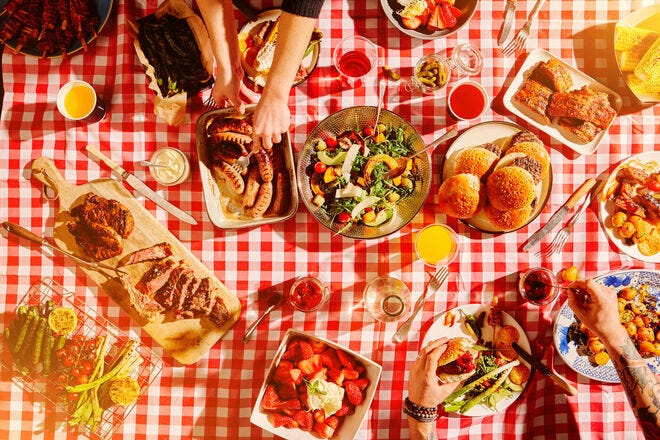Leftover food? Here’s how to store, save, and reuse it
Leftover food form parties and picnics can be safely reused — Photo courtesy of DMP / E+
Whether you order takeout, host a cookout, or prepare a simple meal, there’s a good chance you’ll end up with leftover food. Don’t let all your hard work and money go to waste!
Here’s everything you need to know about how long leftovers last, how to store leftover food, and how to find the best storage containers to keep your food fresh and safe.
How long do leftovers last?
According to the United States Department of Agriculture, you can store most leftover food in the refrigerator for three to four days. It can also be stored in the freezer almost indefinitely without compromising safety, but the food may lose flavor and texture after three to four months. No one wants that; eat leftovers sooner rather than later to enjoy them at their best.
The best temperatures for safely storing leftover food
 Leftover food should be properly stored — unless it was in the danger zone too long — Photo courtesy of LindasPhotography / iStock Via Getty Images
Leftover food should be properly stored — unless it was in the danger zone too long — Photo courtesy of LindasPhotography / iStock Via Getty Images
The danger zone for food is 40 to 140 degrees — that’s when it becomes a breeding ground for bacteria. If you need to leave hot food out for over two hours, use chafing trays, slow cookers, or warmers. For cold foods, nest serving dishes on ice. You should discard any food left in the danger zone for over two hours.
If you’re entertaining and need to leave food out longer than two hours, serve smaller portions and rotate extras between the table and oven or refrigerator to maintain the proper temperature.
Cook leftover raw meat before you refrigerate
The USDA suggests refrigerating uncooked ground meats, poultry, pork, liver, and stew meats for one to two days. If you bought a few too many burgers for the grill, store them. If you aren’t going to cook the raw meat right away, cook or freeze it.
Uncooked steaks, chops, and roasts last three to five days in the refrigerator. Cooking or freezing them can extend their shelf life. Cured meats like bacon, salami, and ham last up to seven days in the fridge.
Use airtight containers to store leftover food
 Airtight containers are the best way to store leftover food — Photo courtesy of vgajic / E+
Airtight containers are the best way to store leftover food — Photo courtesy of vgajic / E+
Shoving a takeout container or a plate of leftovers in the fridge may be easy, but it isn’t always the best idea. Air is the enemy of your leftovers. When food is exposed to air, it is more likely to dry out, absorb odors, and develop bacteria.
For the best results, wrap your leftovers tightly or place them in airtight storage containers before you put them away. (Read on below for our picks for the best glass containers and storage containers with lids.)
Shallow containers are best for storing leftover food
A giant vat of soup or pasta sauce takes considerable time to cool down, even in the freezer or refrigerator. If your leftovers are still hot, it’s best to transfer them into shallow containers to allow your food to cool off quickly.
Portion out leftover foods before freezing
Leftovers dry out when reheated. If you’re storing leftovers in the freezer, portion them out in advance so they won’t freeze together and force you to reheat an entire container when you only need one or two servings.
Vote Now: Best Fast Food Restaurant (10Best Readers’ Choice Awards 2024)
Store starches and sauces separately
If you have leftover sauce and pasta or rice, store them in separate containers. This will prevent your starches from becoming soggy, bloated, and generally unappetizing. It may also help your leftovers last longer since cooked pasta lasts longer than most sauces.
How to safely thaw frozen leftover food
 The safest ways to thaw frozen food are with cold water, in the microwave, or the refrigerator — Photo courtesy of tylim / iStock Via Getty Images
The safest ways to thaw frozen food are with cold water, in the microwave, or the refrigerator — Photo courtesy of tylim / iStock Via Getty Images
Resist the temptation to thaw frozen leftovers on the counter. The USDA says the safest ways to thaw leftovers are in the microwave, refrigerator, or in cold water. The refrigerator method takes the longest, so you’ll need to plan. For the cold water method, place your leftovers in a leak-proof bag or container and submerge them in cold water (either a sink or large bowl will suffice for this).
To thaw frozen leftovers in the microwave, cook in defrost mode until a meat thermometer registers 165 degrees. Stir or rotate the food periodically to ensure it thaws evenly.
How to reheat leftover food on the stovetop
Sauces, soups, and gravies can be heated to a rolling boil on the stovetop. Cover them with a lid to prevent leftovers from drying out, and stir periodically for even cooking.
How to reheat leftover food in the microwave
Cover your dish before reheating it in the microwave. Use a microwave-safe dish and arrange the food evenly. Add a few drops of moisture if necessary. Be sure to vent the cover so the steam can escape. Microwaves are notorious for uneven cooking, so check for cold spots before serving.
Vote Now: Best Fast Food Burger (10Best Readers’ Choice Awards 2024)
How to reheat leftover food in a conventional oven
 Using a conventional oven is one of the safest ways to reheat leftover food — Photo courtesy of monkeybusinessimages / iStock Via Getty Images
Using a conventional oven is one of the safest ways to reheat leftover food — Photo courtesy of monkeybusinessimages / iStock Via Getty Images
Transfer your leftovers into an oven-safe dish and cover with a lid or foil to trap moisture. Set the temperature to a minimum of 325 degrees and use a meat thermometer to check the temperature before serving. Most leftovers are safe to eat when they reach an internal temperature of 165 degrees.
Never reheat leftover food in a slow cooker
Slow cookers are good for many things, but reheating leftovers isn’t one of them. As the name implies, they are slow, which means your leftovers might spend more than two hours at unsafe temperatures.
If you want to serve your leftovers in a slow cooker, heat them first and then transfer them to the preheated slow cooker after they reach safe temperatures.
The best food storage containers
Rubbermaid Brilliance glass food storage containers with lids
Rubbermaid Brilliance glass containers with lids with lids are leak-proof and airtight. Built-in vents make it easy to microwave without the mess. They come in a variety of sizes, and the lids are interchangeable with the rest of the Rubbermaid Brilliance line. The containers are not only microwave, oven, freezer, and dishwasher safe but also stain and odor-resistant.
Amazon Basics Tritan locking food containers with lids
Amazon Basics Tritan locking food containers with lids are our pick for the best plastic food containers because they offer excellent value. The lids are leak-proof and airtight; the containers are microwave, freezer, and dishwasher-safe. They’re also stain-resistant and odor-resistant and come in various sizes.
Zip-Top reusable food storage bags
Zip-Top reusable food storage bags are as sturdy as traditional food storage containers. They are microwave, freezer, and dishwasher safe. We also love that the built-in zipper at the top eliminates the need for a separate lid. Although more expensive than disposable storage bags, they are endlessly reusable and help you save money and eliminate waste in the long run.




